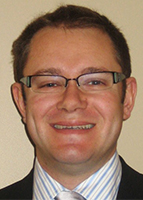Time: 19th July, 2018, 10:00-11:30 am
Venue: 1st Floor Conference Room, Basic Energy Builiding
Lecturer: Dr. Frédéric Blanc, Department of Chemistry, Stephenson Institute for Renewable Energy, University of Liverpool, UK

Abstract:
We will present examples of the investigation of the defects chemistry and the Li+ and Na+ diffusion pathways in new solid-state ceramics and glass Li+ and Na+ conductors using an approach focusing on solid-state NMR spectroscopy techniques and integrating diffraction and computational modelling-based studies.
Calculation of the energetics of aliovalent substitution into the olivine LiMgPO4 suggests that replacement of Mg2+ by In3+ is the most effective way to introduce Li+ vacancies. Experimental synthesis accesses materials with up to 17% Li vacancy content and improved conductivity as revealed by both Li NMR and impedance spectroscopies. Experimental data and calculations reveal that the energy barrier to site-to-site hopping is 0.3-0.5eV, comparable with best-in-class nonoxide systems, but that longer range transport is less facile with activation energies in the range of 0.7-1eV arising from Li+ vacancies strongly bound to the In3+ dopants.
A new class of ABO3 perovskite with Li+ on both the A- and B-sites, La3Li3W2O12, has been found to adopt the structure of a monoclinic double perovskite (A2)BB'O6, (La1.5Li0.5)WLiO6, with rock salt order of W6+ and Li+ on the B-site. Neutron diffraction locates A-site Li in a distorted tetrahedron displaced from the conventional perovskite A-site and is confirmed by Li NMR and DFT, which also suggests local order of A-site. Li+ ion dynamics, probed by molecular dynamics and Li NMR, occur via a pathway involving a series of multiple localized Li hops between two neighboring A-sites (~0.25 eV), with additional possible pathways involving Li exchange between the A- and B-sites and is comparable to the best oxide Li+ ion conductors.
A similar integrated approach will be presented to investigate the Li+ diffusion pathway in other fast solid-state Li+ ion conductors, including Li-garnet, Li-NASICON and F-doped lithium silicates as well as other Na-containing ceramics will also be presented.
Introduction:
Frédéric graduated from the School of Chemistry in Lyon (France) in 2004 and obtained his PhD in Chemistry in 2008 from the University of Lyon and the European Center for High Field NMR in Lyon, under the supervision of Prof. Christophe Copéret and Prof. Lyndon Emsley. He studied the structure - dynamics relationship in heterogeneous catalysis and developed new solid state NMR methods to understand the chemistry on surfaces. He then received a Lavoisier fellowship and underwent postdoctoral work at the State University of New York in Stony Brook, NY for three years with Prof. Clare P. Grey, where he got interested in the understanding of the structure elucidation of energy materials with NMR spectroscopy. He then moved to the University of Cambridge as a Marie Curie fellow and looked at the dynamics of oxygens and protons in electrolytes by high temperature NMR spectroscopy. In December 2012, he was appointed to a Lectureship in the Department of Chemistry and the Stephenson Institute for Renewable Energy at the University of Liverpool and promoted to Senior Lecturer in 2016, where he is focusing on the development and application of NMR spectroscopy in materials chemistry.
Contact: SHI Ying, Group 502
Phone: 84379128